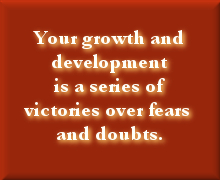Your growth as an artist and as a human being lies in the constant development of your instrument, which includes your instincts, your mind, and your storehouse of knowledge. It is a series of victories — sometimes small — over fears and doubts. Through practical  advancement and application (that is, by doing rather than talking or fretting about), it is the continual building up of that list of things that change from “I couldn’t possibly” to “yes, I can”. You might never be among the ranks of the great singers but, by gum, by taking it on, you will be better and not afraid to do it when the circumstances call for it. You will become better and better prepared, more directable, and more marketable.
advancement and application (that is, by doing rather than talking or fretting about), it is the continual building up of that list of things that change from “I couldn’t possibly” to “yes, I can”. You might never be among the ranks of the great singers but, by gum, by taking it on, you will be better and not afraid to do it when the circumstances call for it. You will become better and better prepared, more directable, and more marketable.
Tag Archives: actor’s task
Where’s My Mind?
I’ve written a lot about critical thinking in the last few blog posts, partially because I believe it’s something that’s currently lacking to a great degree in our culture and particularly in the arts. In future blog posts, I’ll expand on this and explore the interplay of imagination and rational thinking.
As I have said previously, almost anyone could stand on the stage and “feel”. But could you do it again? You and I could scream our lungs out at each other. “Wow! I really felt that!” we might say afterwards, licking our chops like cats. But would it serve the play, be interesting and appropriate, or would it just be emotional masturbation? And again, could either of us do that again and again without very rapidly wrecking our voices?
In the end, who really cares if you “felt” it or not? The real test is: Were you able to convey across the footlights the impression that the character was feeling whatever emotion of the moment, by whatever path you took to get there?
Simple emotional indulgence is not only boring to watch, it’s a cheat. You might start by getting “feelings” but can you justify them after the fact?
Continue reading Where’s My Mind?
And Now . . . Keep Building The Approach
It’s so great to hear from all of you who have been following the blog and especially those of you who are trying the exercises in our last several posts (click here, and here to review those exercises or to do them now if you haven’t done so).
I know that this is new and strange territory for some of you and I admire your courage in challenging yourselves to try something different, to speak up when you don’t understand, and to just “go with it” and see where it takes you. Please keep doing all that and also submitting your comments on each post page or speaking to me “offline” or both!
If you do use the “comments” feature, it helps us all to see what others are grappling with or how they are approaching things. It’s amazing how alike we can be and really fun to explore our differences as well. I know that I learn a lot from seeing the various approaches that people take and where their imaginations lead. Your creativity helps me to be more creative and I hope you will find the same experience in sharing with others here.
I’ve stressed throughout these introductory exercises that there’s no “right” or “wrong” answers. The point is really to expand horizons. To let your imagination develop, partly through a “metaphorical” approach; that is, through using one creative or artistic medium to talk about another. In these cases, we’ve used light and shadow, color and tone, depth and angle, “inclusion” and “exclusion” — all found in photographs — to help us explore what stories interest us, how we might relate these stories as writers or directors, and why.



